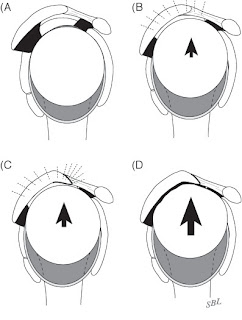In the management of partial thickness cuff tears, the first line of treatment is stretching the shoulder to eliminate any tightness of internal rotation with the arm at the side
and cross body adduction
Often, as is the case with tennis elbow, progressive stretching exercises will eliminate the tightness and even out the distribution of force so that comfort and function are restored in the presence of a thinned tendon.
If symptoms are refractory to non-operative management, consideration can be given to a surgical release of the insecurely attached fibers at the margin of the tear – a procedure we refer to as cuff curettage (more on this later). This can be accomplished through a small deltoid split through which the location of the partial detachment can be confirmed by palpation of the thinned tendon. A small curette is inserted in the area of the detachment and used to release the weakly attached fibers around the periphery of the defect, leaving only the securely attached fibers to transmit the force of the muscle to bone. Since there is no deltoid detachment and no cuff repair, stretching and active use can be started immediately after surgery using the same exercises that were learned by the patient as a part of the non-operative program described in the previous paragraph.
In all cuff surgery, an important goal is to assure the smooth passage of the rotator cuff beneath the coracoacromial arch. Roughness can be detected at surgery by placing the fingers of one hand on the acromion while the arm is passively rotated throughout its range of motion.
The positions productive of crepitance are noted and, before wound closure, relief of this crepitance is verified. The source of subacromial crepitance is usually some combination of bursal hypertrophy, roughness on the upper surface of the cuff, and roughness around the humeral tuberosities. While it is our surgical routine to palpate the undersurface of the coracoacromial arch for sources of roughness, the acromion and the coracoacromial ligament are almost always smooth. While the presence of ‘spurs’ may be suggested on preoperative radiographs, these are usually only calcifications in the coracoacromial ligament and, as such, do not encroach on the free movement of the cuff beneath it.
Smoothness of the humeroscapular motion interface is assured by resecting any abnormal bursa or scar in this interface from the axillary nerve inferior-medially, between the subscapularis and the coracoid muscles, under the acromion, and down to the axillary nerve posterior inferiorly – a complete ‘nerve-to-nerve’ release.
internal rotation of the arm in 90 degrees of abduction, the sleeper stretch
and cross body adduction
Often, as is the case with tennis elbow, progressive stretching exercises will eliminate the tightness and even out the distribution of force so that comfort and function are restored in the presence of a thinned tendon.
If symptoms are refractory to non-operative management, consideration can be given to a surgical release of the insecurely attached fibers at the margin of the tear – a procedure we refer to as cuff curettage (more on this later). This can be accomplished through a small deltoid split through which the location of the partial detachment can be confirmed by palpation of the thinned tendon. A small curette is inserted in the area of the detachment and used to release the weakly attached fibers around the periphery of the defect, leaving only the securely attached fibers to transmit the force of the muscle to bone. Since there is no deltoid detachment and no cuff repair, stretching and active use can be started immediately after surgery using the same exercises that were learned by the patient as a part of the non-operative program described in the previous paragraph.
In all cuff surgery, an important goal is to assure the smooth passage of the rotator cuff beneath the coracoacromial arch. Roughness can be detected at surgery by placing the fingers of one hand on the acromion while the arm is passively rotated throughout its range of motion.
The positions productive of crepitance are noted and, before wound closure, relief of this crepitance is verified. The source of subacromial crepitance is usually some combination of bursal hypertrophy, roughness on the upper surface of the cuff, and roughness around the humeral tuberosities. While it is our surgical routine to palpate the undersurface of the coracoacromial arch for sources of roughness, the acromion and the coracoacromial ligament are almost always smooth. While the presence of ‘spurs’ may be suggested on preoperative radiographs, these are usually only calcifications in the coracoacromial ligament and, as such, do not encroach on the free movement of the cuff beneath it.
Smoothness of the humeroscapular motion interface is assured by resecting any abnormal bursa or scar in this interface from the axillary nerve inferior-medially, between the subscapularis and the coracoid muscles, under the acromion, and down to the axillary nerve posterior inferiorly – a complete ‘nerve-to-nerve’ release.
Complete release of the external surface of the supraspinatus and infraspinatus can be verified by passing a smooth elevator between each tendon and the coracoacromial arch.
--
How you can support research in shoulder surgery Click on this link.
Here are some videos that are of shoulder interest
Shoulder arthritis - what you need to know (see this link).
How to x-ray the shoulder (see this link).
The ream and run procedure (see this link).
The total shoulder arthroplasty (see this link).
The cuff tear arthropathy arthroplasty (see this link).
The reverse total shoulder arthroplasty (see this link).
The smooth and move procedure for irreparable rotator cuff tears (see this link).
Shoulder rehabilitation exercises (see this link).







